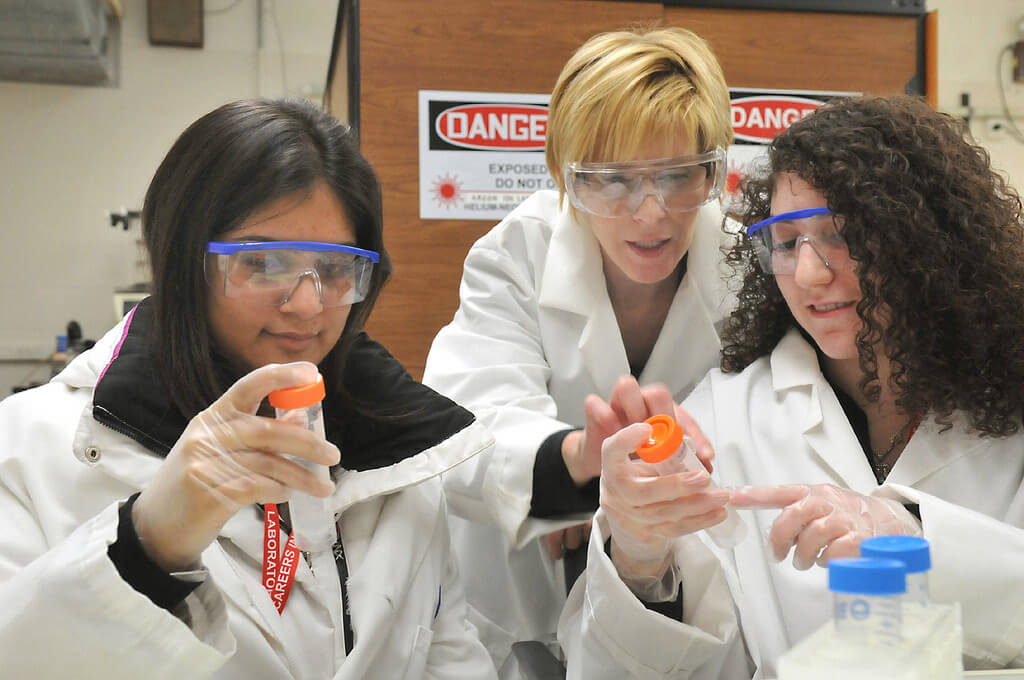Key Takeaway: STEM is an acronym for science, technology, engineering, and math. Not only does receiving a STEM education result in high-paying careers and job stability, given the projected growth and numerous job openings in these fields, but it also develops a wide range of soft and hard skills that can be used in a variety of industries. When educators invest in STEM education that begins in preschool and continues post-high school, they can help prepare all students for careers and encourage future problem solvers.
 As technology and engineering continue to grow and evolve, receiving an education with a focus on science, technology, engineering, and math (STEM) can open doors to many career opportunities. The skills one gains from a STEM education are among the most sought-after on the job market.
As technology and engineering continue to grow and evolve, receiving an education with a focus on science, technology, engineering, and math (STEM) can open doors to many career opportunities. The skills one gains from a STEM education are among the most sought-after on the job market.
Are you interested in receiving a STEM education? It can be a valuable investment for both your professional growth and advancement. Here’s a guide on why this education is so great.
What Is STEM?
STEM is short for science, technology, engineering, or math. If you’re majoring in STEM, you’ll be studying one of those subjects. The programs that fall under the STEM umbrella usually focus on research, innovation, and the development of new technologies.
STEM degrees are increasingly valuable in the 21st century. In fact, occupations in STEM are projected to grow by 8% by 2029, according to the US Bureau of Labor Statistics. By earning a degree in one of these fields, you could be prepared for a variety of in-demand and high-paying careers. Here are some STEM majors that are available:
- Astronomy
- Biology
- Chemical Engineering
- Chemistry
- Computer Science
- Data Scientist
- Earth Sciences
- Engineering
- Health Sciences
- Information Technology
- Mathematics
- Mechanical Engineering
- Nursing
- Physics
- Statistics
- Veterinarian
- Web Developer
What To Expect From STEM Education
Students are sometimes discouraged from pursuing an education in STEM because they believe it is too difficult, too challenging, and simply inaccessible. But the reality is, if a student is willing to put in the effort, success in these programs is attainable. In a STEM program, you can expect to:
- Develop strong critical thinking skills by analyzing information to make informed decisions.
- Master data analysis by learning how to collect and organize data in a meaningful way.
- Apply your knowledge to real-world challenges through hands-on projects and experiments.
- Develop a strong foundation in math and science concepts.
- Think outside the box to come up with new and creative ideas.

The Benefits of Getting a STEM Education
STEM education can be valuable to all students. It can help you develop skills that can be applied outside of the classroom. Here are some of the benefits:
1. You’ll Be Qualified for Future Careers
Based on the current growth of STEM careers, predictions indicate that these fields will continue their swift development. The hard and soft skills developed in mathematics, problem-solving, data analysis, and engineering will continue to be coveted in fields of study like engineering, chemistry, and information technology. However, these talents will also be highly sought after in professional fields unrelated to STEM, such as business, communications, and design.
You’re Likely To Earn a High Salary
There is a high demand for experienced engineers, scientists, mathematicians, and computer experts. Companies are addressing this need by offering competitive salaries, bonuses, and perks in return for valuable expertise and loyalty. They are willing to invest significantly in forward-thinking ideas and innovative solutions. Based on 2023 data from the Bureau of Labor Statistics (BLS), here are the median salaries you can expect to earn depending on your field of study:
- Science professionals: $78,280
- Technology professionals: $104,420
- Architecture and engineering professionals: $91,420
- Math professionals: $101,460
There Is Job Security
As tech, science, and engineering companies continue their exponential rise, the number of STEM jobs will grow proportionally. For example, the BLS projects about 136,800 job openings in science, 377,500 job openings in technology, 188,000 job openings in engineering, and 33,500 job openings in mathematics. STEM jobs are projected to grow far faster than average between 2022 and 2032.
This trend will drive a huge demand for experts. As a result, those who study STEM will be less likely to face unemployment after graduation. They can rest assured knowing their careers will be profitable for years to come. Although the rigor of a STEM course load can be challenging, pushing on to become a professional will be rewarded with job security and the freedom to innovate.
Why Schools Should Promote STEM Education From an Early Age
Children have a natural curiosity and can easily learn math and science through play. However, many students miss out on STEM education due to insufficient funding for updated technology and materials or a lack of qualified teachers.
Despite these challenges, it’s crucial to expose students to STEM opportunities and diverse career paths early on. Education programs should integrate more STEM content to equip teachers with the skills and confidence needed to nurture children’s curiosity.
When students see real-world applications of STEM principles, it ignites their curiosity and motivates them to explore these fields further. By investing in STEM education, schools aren’t just preparing students for careers—they’re fostering a new generation of innovators and problem solvers.
If you’re interested in science, technology, engineering, or math, and enjoy solving problems and thinking creatively, pursuing a STEM education could be the perfect fit. While no educational or career path comes with guarantees, STEM offers some of the most promising opportunities, including in-demand jobs, high-paying positions, and job security. With a strong foundation in STEM, you’ll be equipped with the skills and knowledge needed to thrive in an ever-changing world.
Did you know you can use College Raptor’s College Match tool to look for STEM schools around the US based on test scores, cost estimates, acceptance odds, and potential financial aid opportunities? Start today—for FREE!






One of the imaginative and viable techniques for teaching STEM Education is through Robotics, 3D Printing, and Electronic Building Blocks. Great post, thanks